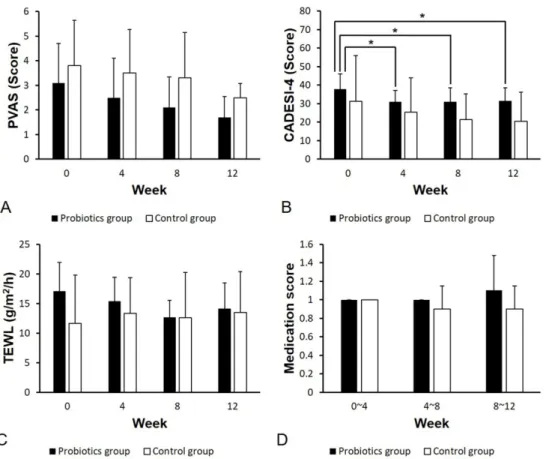https://doi.org/10.14405/kjvr.2020.60.1.19
19 ORIGINAL ARTICLE
Clinical trial of oral administration of Bifidobacterium longum in dogs with atopic dermatitis
Kang-Il Lee
1,†, Taesik Yun
1,†, Junsang Ham
2, Wan-Kyu Lee
3, Ji-Houn Kang
1, Mhan-Pyo Yang
1, Byeong-Teck Kang
1,*
1
Laboratory of Veterinary Internal Medicine, Veterinary Teaching Hospital, College of Veterinary Medicine, Chungbuk National University, Cheongju 28644, Korea
2
National Institute of Animal Science, Rural Development Administration, Jeonju 54875, Korea
3
Laboratory of Veterinary Bacteriology and Infectious Diseases, College of Veterinary Medicine, Chungbuk National University, Cheongju 28644, Korea
Abstract: This study assessed the effects of probiotics in canine atopic dermatitis (AD). We enrolled 11 client-owned dogs with AD and randomly allocated them to two groups. The probiotics group (n = 7) was prescribed with Bifidobacterium longum while the control group (n = 4) received a placebo powder once a day for 12 weeks. In both groups, the degree of skin lesions was evaluated based on the Canine Atopic Dermatitis Extent and Severity Index (CADESI)-4. We also measured the transepidermal water loss (TEWL). We assessed pruritus severity using the pruritus visual analog scale (PVAS). Alteration of consumed drug doses was converted into medication scores. All the evaluation indices were surveyed every 4 weeks. In the probiotics group, there was a significant decrease in the CADESI-4 score at 4, 8, and 12 weeks compared to that of the baseline score (p < 0.05). There was no significant difference in TEWL, PVAS, and medication score at each time point and between groups. Although these results showed that Bifidobacterium longum did not reduce pruritus, TEWL, and the dosage of drugs for canine AD, it was effective in improving skin lesions, therefore, probiotics could be considered in canine AD with severe skin symptoms.
Keywords: Atopic dermatitis, Bifidobacterium longum, dogs, probiotics
Introduction
Canine atopic dermatitis (AD) refers to genetically predisposed allergic der- matosis that causes chronic pruritus associated with exposure to numerous types of environmental allergens [1]. It is generally associated with typical clinical signs and the production of allergen-specific immunoglobulin E (IgE) antibodies [2]. In past decades, the prevalence of canine AD has increased [3].
Various strategies have been proposed to alleviate the clinical signs of canine AD including avoidance of allergens, application of anti-inflammatory drugs, and allergen-specific immunotherapy [4]. Allergen-specific immunotherapy is not a common treatment for canine AD because it requires the long-term sub- cutaneous or sublingual administration of allergens [4]. On the other hand, administration of anti-inflammatory and anti-pruritus drugs including topical/
systemic glucocorticoids, ciclosporin, and oclacitinib is the main treatment option for canine AD. However, since long-term or high-dose use of these drugs has been associated with some adverse effects, concomitantly, a variety of adjunctive methods in the treatment of canine AD have been attempted to reduce the dosage of these drugs.
Studies have reported that probiotics, which are one of the adjunctive treat- ments and include specific microorganisms, could be effective against canine AD [5-7]. The effect of bacteria that produce lactate on canine AD has been described in the International Committee on Allergic Diseases of Animals (ICADA) guidelines [4]. Likewise, numerous human studies using different strains of probiotics have reported probiotics to be effective in improving the clinical signs of AD in young children [8-10]. Although the exact mechanism of the immunomodulatory effect of probiotics in human and canine AD has not been fully understood, a close relationship between intestinal bacterial flora and the numerous factors associated with the pathogenesis of AD has been suggested [11].
*Corresponding author Byeong-Teck Kang
Laboratory of Veterinary Internal Medicine, Veterinary Teaching Hospital, College of Veterinary Medicine, Chungbuk National University, 1 Chungdae-ro, Seowon-gu, Cheongju 28644, Korea
Tel: +82-43-261-3744 Fax: +82-43-267-2595
E-mail: kangbt@chungbuk.ac.kr
†
